Korean Bean Sprout Salad (Kongnamul Muchim)
Bean sprout salad is one of the many healthy Korean side dishes (banchan) made with soybean sprouts. Known as kongnamul muchim, this easy side dish can be prepared in just 10 minutes. It features a crunchy texture and nutty flavor, making it the perfect accompaniment to any Korean or Asian meal.
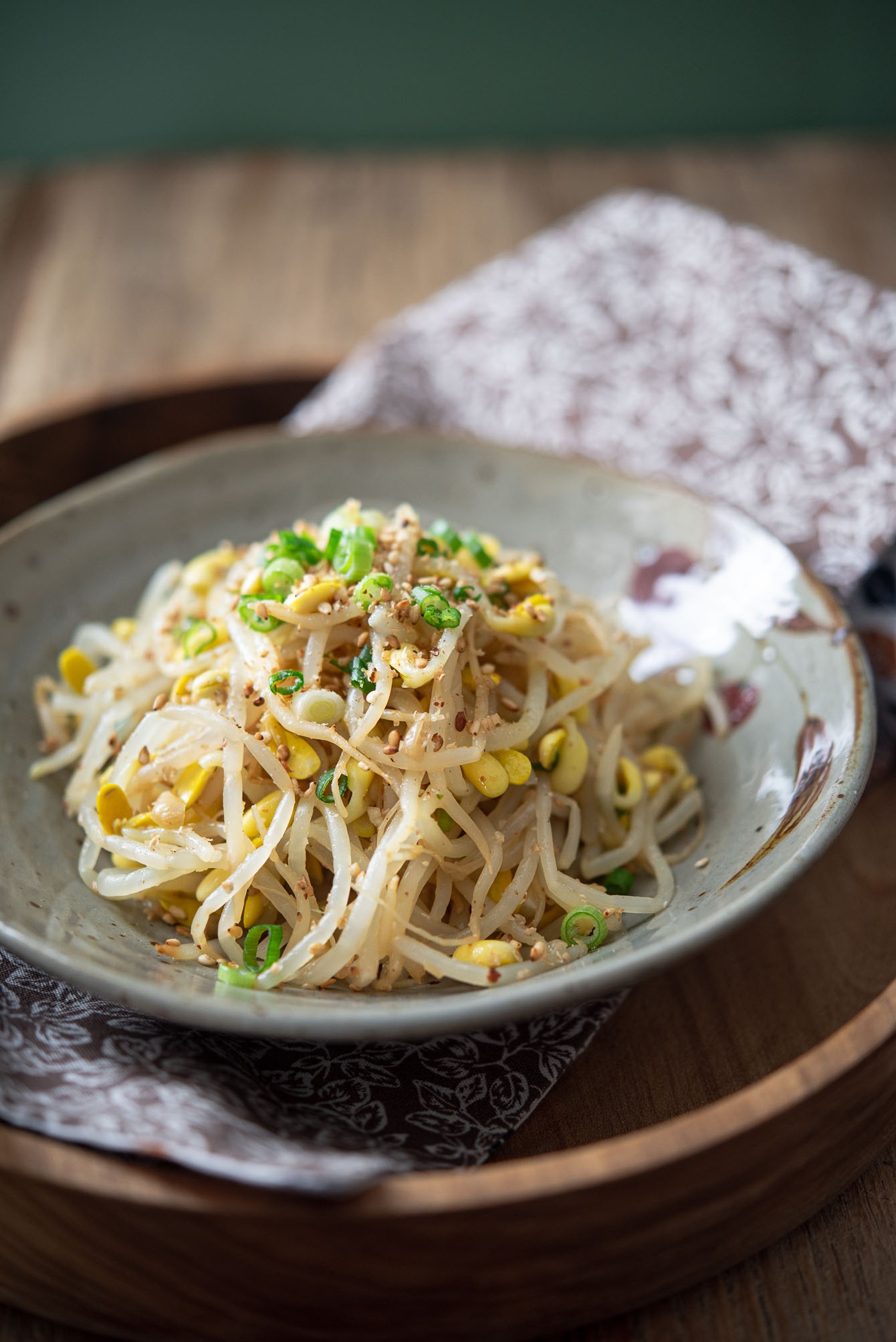
Kongnamul muchim (콩나물 무침) is the name of this bean sprout salad in Korean and is considered the one of the most popular Korean side dishes. It is even known as the “national side dish of Korea (gukmin banchan, 국민반찬)”, along with Korean spinach side dish, because it is consumed at least once a week in every household.
While there are several versions of bean sprout side dishes in Korean cuisine, this one is made with soybean sprouts. For a different twist on bean sprouts, you can try my mung bean spouts salad made with spinach.
In fact, some people even grow their own soybean sprouts at home for convenience. Regardless of how you obtain them, soybean sprouts are an inexpensive and delicious ingredient. The Korean people never tire of making this dish with soybean sprouts.
Looking for another Asian-style of quick salad? Try my Asian-style broccoli salad with sesame dressing. It’s another light and refreshing salad recipe that are great to use as a side dish.
Health Benefits of Bean Sprouts
Bean sprouts, including soybean sprouts, are a nutritious ingredient commonly used in Asian cuisine. They’re a good source of essential vitamins, minerals, and antioxidants that promote health, such as vitamins A, C, and K, folate, and potassium.
Bean sprouts are low in calories, high in fiber, and contain no cholesterol, making them ideal for weight management and digestive health. Additionally, they may help regulate blood sugar levels, boost immune function, and provide protection against chronic diseases like cancer, heart disease, and diabetes.
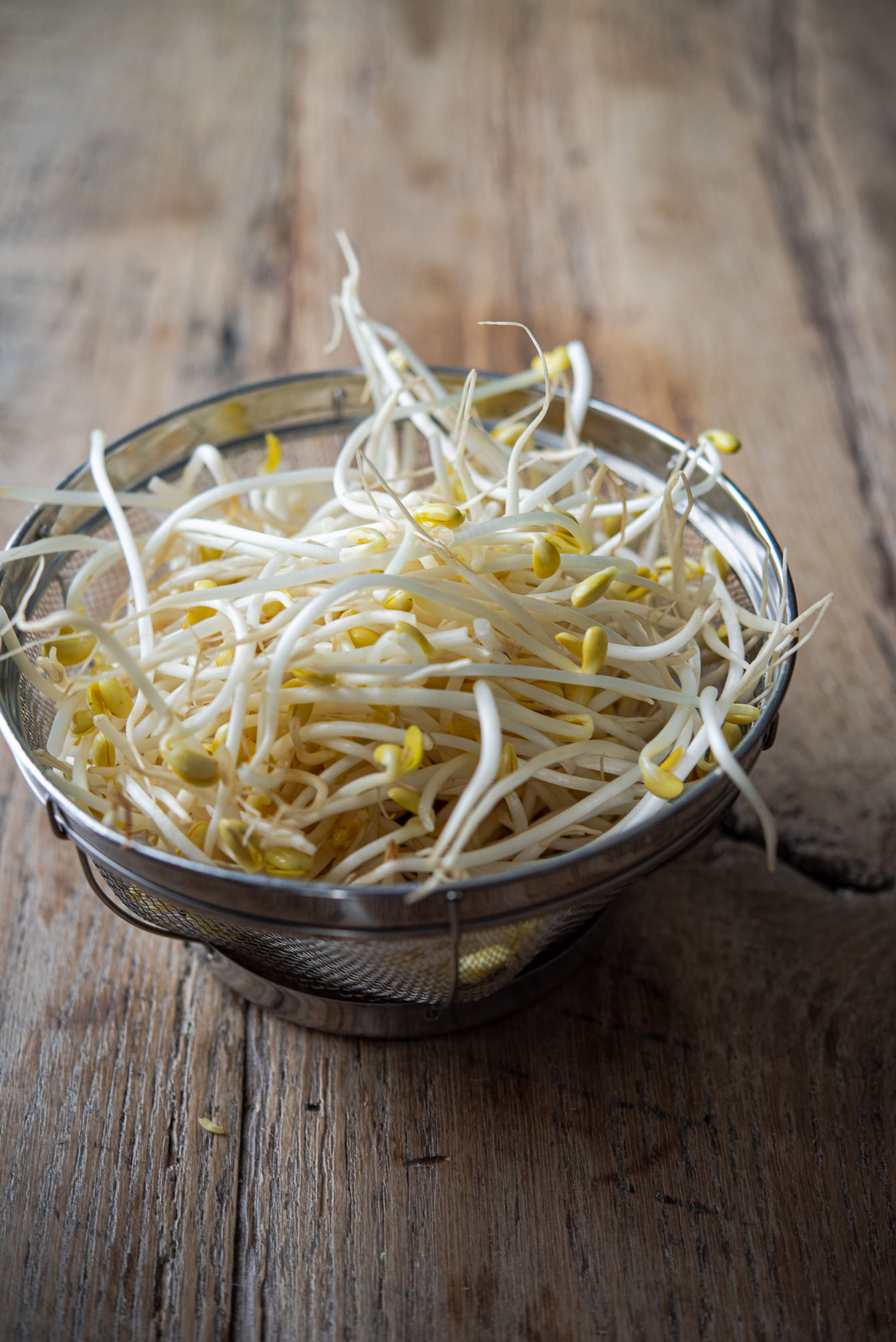
Soybean Sprouts
Soybean sprouts are a popular ingredient in Korean cuisine, known for their crunchy texture and nutty flavor. While they can be eaten raw, they are commonly cooked in Korea.
There are two main types of Korean soybean sprout salad: a mild nutty soybean sprout recipe and a spicy version that adds Korean chili flakes to the salad. If you’re looking for a bit of heat, you can check out my spicy soybean sprout salad recipe.
Whether you prefer mild or spicy, this bean sprout salad is easy to make and incredibly delicious. It’s also a great base for making Bibimbap, a Korean rice bowl with vegetables.
Recipe Tips and Advice
To remove or not to remove the tail part of soybean sprouts?
It is a very personal choice. While some Korean cooking purists may recommend it to create a more visually appealing salad, most people don’t bother with the extra step. Personally, I don’t remove the tails either.
Use very little water to cook
Commonly, soybean sprouts are cooked in a pot of boiling water, but this method may cause the loss of both nutritional value and flavor.
To prevent this, I recommended using only a small amount of water, around 4 tablespoons, when cooking soybean sprouts. This is because the sprouts release moisture during cooking, and this natural liquid is sufficient to cook them.
By using minimal water, you can retain the sprouts’ nutritional value and enhance their natural flavor.
Do not rinse after cooking the sprouts
Unlike in other cuisines, we don’t rinse cooked bean sprouts in Korean cuisine. To ensure optimal flavor and texture, it’s important not to overcook the sprouts.
The retained heat in the sprouts will continue to cook them further, so it’s best to remove them from heat just before they’re fully cooked. Simply drain them after cooking. This way, the sprouts will maintain their natural flavor and texture.
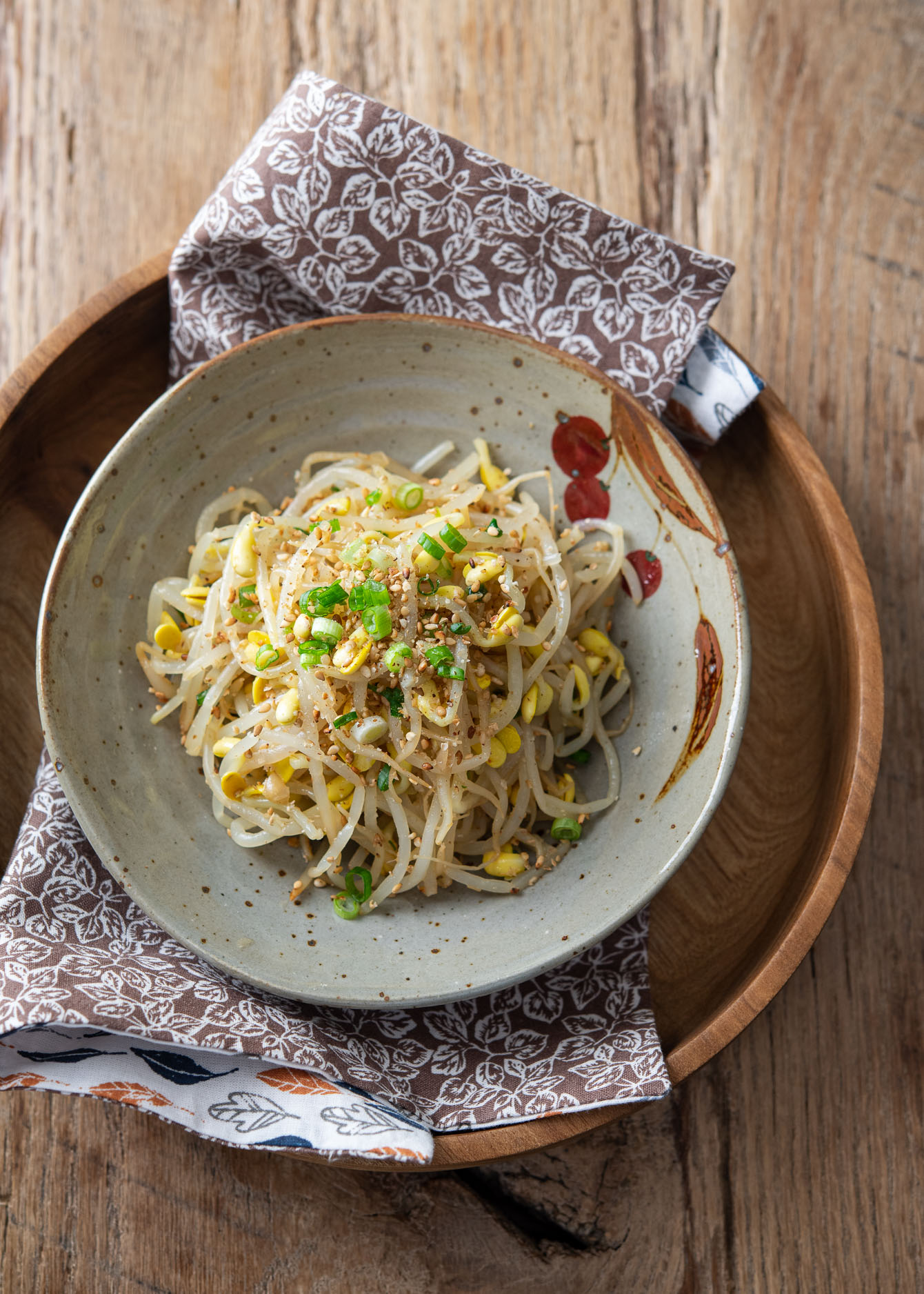
Ingredients List
- Soybean sprouts with or without the tail part
- Garlic, finely minced for added flavor
- Green onion, which adds a savory touch
- Sesame oil, which provides a nutty aroma and fragrance
- Toasted sesame seeds, always use toasted for the best flavor
- Korean soup soy sauce, which is different from regular soy sauce
- Salt, as needed to enhance the taste
- Water, only 4 tablespoons are necessary
How to make bean sprout salad (kongnamul muchim)
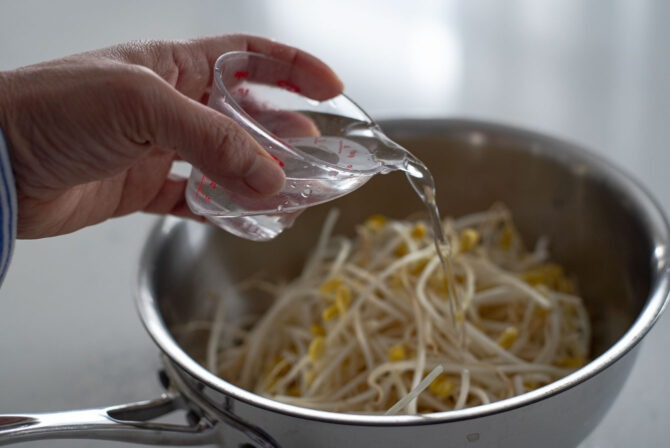
Step 1. Add little water
Put sprouts in a pot and pour in 4 tablespoon of water.
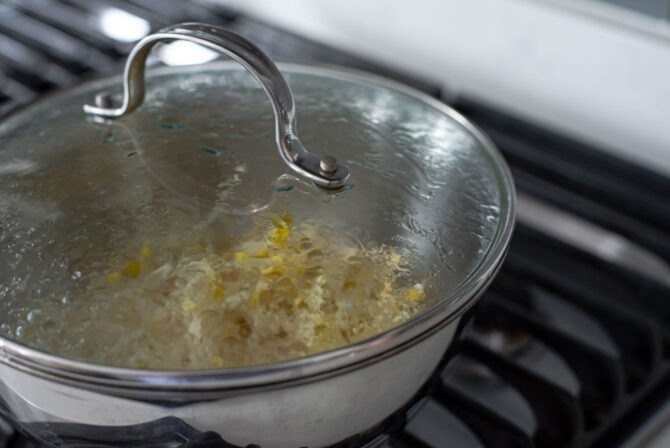
Step 2. Steam
Close the lid tightly and let the sprouts cook over medium heat for 6 minutes. Do not open the lid. If you have a glass lid, you will see the steamed water drips down under the lid.
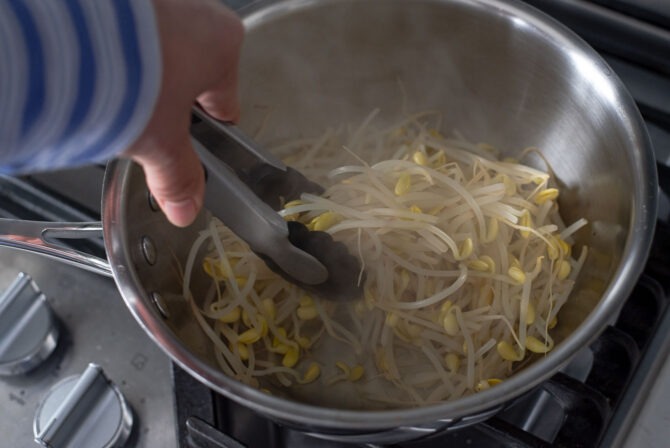
Step 3. Toss in a pot
Remove the pot from the heat and open the lid. Stir and turn the sprouts so that the ones on the bottom come to the top and the ones on the top end up on the bottom, and wait for 30 seconds.
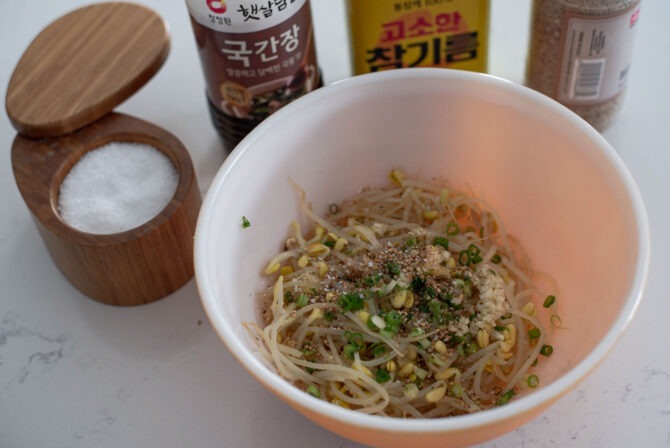
Step 4. Season
Drain the spouts in a colander to remove the extra water and let cool for a couple of minutes. Place the warm sprouts in a large mixing bowl. Add garlic, green onion, Korean soup soy sauce, sesame oil, toasted sesame seeds, and a pinch of salt.
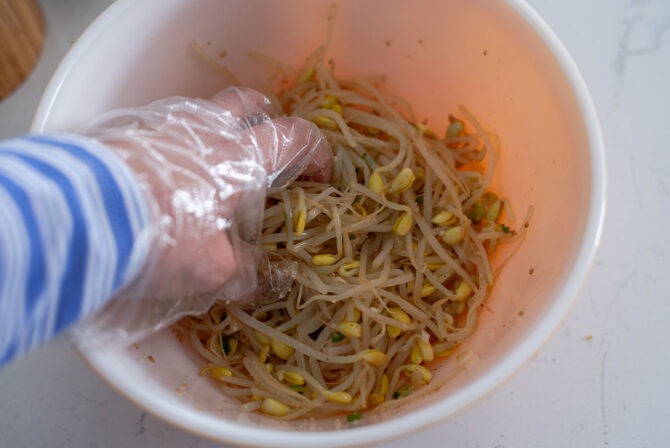
Step 5. Hand toss to mix
Toss the salad with your hand or using kitchen tongs to mix well. Taste the salad and add more salt if needed.
Korean Dishes to Serve With
The Kongnamul muchim is a versatile and delicious accompaniment to many popular Korean dishes, such as:
- Beef Bulgogi (Korean BBQ Beef)
- Spicy Pork Bulgogi (Jeyuk Bokkeum)
- Chicken Bulgogi (Korean BBQ Chicken)
- Korean Fried Chicken
- Dakgalbi (Spicy Korean Chicken Stir-Fry)
- Kimchi Jjigae (Kimchi Stew)
- Dakdoritang (Spicy Korean Chicken Stew)
Storage Tips
To store Kongnamul side dish, either serve it at room temperature or chill it in the refrigerator until ready to serve. The salad keeps in the fridge for up to 1 week, making it a convenient dish to prepare ahead of time.
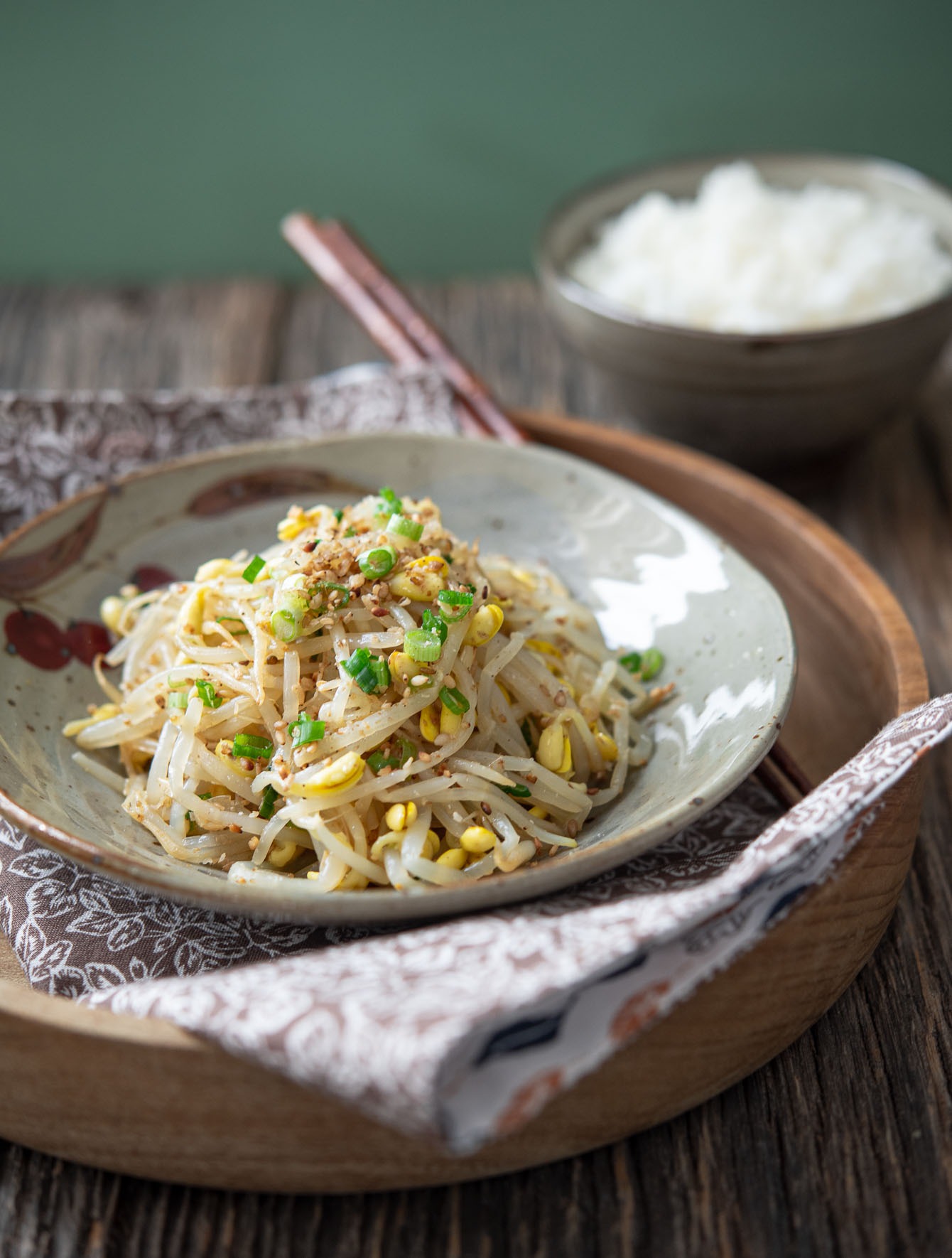
5 Must-Try Korean Side Dishes
- Korean Cucumber Salad (Oi Muchim): Thinly sliced cucumbers with a spicy, sweet, and tangy dressing makes a refreshing salad.
- Quick Braised Tofu Recipe: Simple yet flavorful side dish features bite-sized pan-fried tofu cubes in a savory sauce.
- Korean Spinach Side Dish in 2 Variations: Versatile spinach side dish in two ways
- Korean Braised Lotus Root: Lotus root slices in a flavorful sauce made with soy sauce, sugar, and spices.
- Korean Pan-Fried Potatoes (Gamja Bokkeum): Popular potato side dish in Korean cuisine. You can stir-fry the potato alone or with other vegetables.
If you try this Korean bean sprout side dish recipe, please take a moment to leave a rating and comment below. I love hearing from you, and it helps other readers, too.
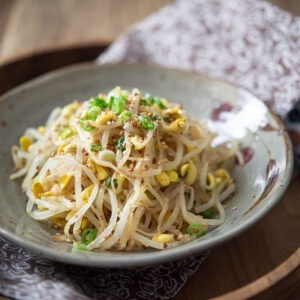
Korean Bean Sprout Salad (Kongnamul Muchim)
Ingredients
- 12 oz (340 g) soybean sprouts, cleaned
- 4 tbsp water
- 1 clove garlic, finely minced
- 1 green onion, finely chopped
- 1 tbsp sesame oil
- 1 tbsp toasted sesam seeds
- 2 tsp Korean soup soy sauce (gukganjang)
- pinch salt, as needed
Instructions
- Put sprouts in a pot and pour in 4 tablespoon of water. Close the lid tightly and let the sprouts cook over medium heat for 6 minutes. Do not open the lid. If you have a glass lid, you will see the steamed water drips down under the lid.
- Remove the pot from the heat and open the lid. Stir and turn the sprouts so that the ones on the bottom come to the top and the ones on the top end up on the bottom, and wait for 30 seconds.
- Drain the spouts in a colander to remove the extra water and let cool for a couple of minutes.
- Place the warm sprouts in a large mixing bowl. Add garlic, green onion, Korean soy soy sauce, sesame oil, toasted sesame seeds, and a pinch of salt. Toss the salad with your hand or using kitchen tongs to mix well.
- Taste the salad and add more salt if needed. Serve at room temperature or chilled.


Ooops! I did wonder about the instruction to steam the Bean Sprouts for 6 minutes, as I thought that sounded like a long time…I did so, but they turned out soggy and limp, and had lost their crispness, so it ruined the recipe. Next time I’ll only steam them for a couple of minutes, if that.
Since I moved from Los Angeles, where there is a huge Korean community, to a rural area where there are only just now a few Korean eating establishments popping up, I’m glad to have authentic Korean sources. I’ve been making Bulgogi for years, and I’m going to use this recipe for the Bean Sprouts tonight to go with it. I used to frequent a great Korean restaurant down south that served a lettuce salad with a wonder, light dressing. I wish I could find that recipe. Kams’hamida!
I love Korean food and don’t have a whole lot of options near me. Made this dish myself and it tasted just as delicious as the one I had in a restaurant. Tasty!
After seeing the other two sites and their recipes, I think this one reigns supreme because of the tip about steaming and using minimal water. Although, when it comes to soy sauce, many people not familiar with Asian culture, do not get the difference between Hawaiian, Korean, Chinese soy sauce, yet alone usukuchi, koikuch, tamari, soy sauce. Since, I’m a noob to Korean soy sauce, I’m not sure what “Korean soup soy sauce is.” I will have to Google it! Keep up the great work.
Hi Greg
Thanks for your comment. If you want to know more about Korean soup soy sauce, I have a pantry page on my site homepage with a collection of Korean condiments. There you will find the information about Korean soup soy sauce. Hope this helps. Thank you so much.
I like garlic but that much garlic un-cooked felt like a little bit too much for everyone. I guess 1/2 clover is ok if this is the first time you make this recipe.
This was really good and really easy. It doesn’t really stand on its own as a side, but adds a nice variation when serving a number of side dishes.
How is Korean soup soy sauce (gukganjang) different from soy sauce besides being lighter? Is it closer to white soy sauce used for lighter dishes and soups? What other uses for this? I have hundreds of different sauces and do not want to buy another one unless it is really needed.
Korean soup soy sauce is a by-product of Korean soybean paste (doenjang) and it is saltier than regular soy sauce. It also has more pungent and umami taste than regular or light soy sauce. If you like to make Korean soups and stews, and some of vegetable side dishes, (and even Korean beef bulgogi) that are asking for Korean soup soy sauce, I recommend getting one. It is hard to replace with another sauce since the flavor is so unique to Korean cuisine. For this recipe, you can skip soup soy sauce and use salt instead if you wish to, but adding soup soy sauce adds umami that salt alone can’t.
I make this salad all the time. Love it!!!! Goes with a lot of dishes.
Great! Thanks.
Hi Holly
I come from Vietnam where definitely be familiar with green bean sprout, however one day I came to KingBBQ restaurant and ate panchan made with soybean sprout. I was totally amazing that it is more crunchy and sweet. After that day I have been trying to make bean sprout with soy bean but never being successful. Hope someday you can write how to make it at home.
I loved the salad! Thank you so much for the great easy to make and delicious recipe!
Wow what a healthy little dish to serve with anything
It was a hit with all the family…now making it very often!!
thank you again
Michel
I love Korean food and I always visit your site for Korean recipes.
My family specially love the Gabi Jjim and it’s always requested when we have get together.
I want to try your side dishes, If I want to make lots of it to store (just like what I see in Korean Dramas) how long can it last good in the fridge?
Hi Tamy
The storage life of side dishes is depending on the ingredients. Fresh vegetable side dishes will last about 1 week in the fridge, cabbage kimchi will last 2-3 month (but still usable afterward), radish kimchi is about 1 month, dried goods (beans, fish, etc) are about 1 month. Salad type last just a couple of days. Kimchi-s will last fresh longer if stored in kimchi refrigerator.
Thanks for sharing your thoughts about bean sprout.
Regards
Thanks for your namul recipes! I love Korean food always wanted to try making various namul at home, but never found recipes that I like.
I shall try your recipes since they don't require too many ingredients, and are basic ingredients found in most homes.
Thanks. Let me know how you like it.
Your blog is wonderful! I'm going to follow it and try all your recipes. You're such a great cook!
I LOVE this blog! Your pictures are AMAZING! I'm bookmarking you and look forward to seeing many more recipes. I actually am making my very first attempt at sprouting bean sprouts at this very moment – I'll let you know how it goes. I love them, but don't like driving 20 miles to the nearest Korean market to buy them. I hope your recipe turns out better than the way I usually prepare them – they taste okay, but not KOREAN, if you know what I mean… I usually use dashida (I know – you're cringing as you read that!). Keep the recipes coming Holly!! You'll make a true Korean chef out of me after all!